by David M. Roth
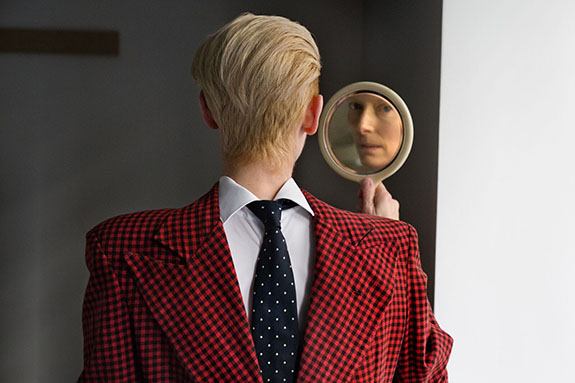
Anyone who engages seriously or even casually with photography soon learns that the camera lies. It’s not a built-in shortcoming – cameras capture what they “see.” The problem is that facts captured in often fail to reveal deeper truths. That realization jumpstarted the career of Duane Michals, 86, a relentlessly idiosyncratic artist who’s arguably had a more enduring impact on contemporary photography than almost any other figure you can name.
Duane Michals: The Portraitist, an engrossing exhibition at the Crocker Art Museum featuring 135 images, culled from a 60-year career by the DC Moore Gallery, shows why. It attempts no neat summation, perhaps because no such summary is possible. Instead, it lays out key examples of the myriad and often unruly experiments of an artist dedicated to challenging two ideas that dominated 20th century photography: Henri Cartier Bresson’s “decisive moment” and the pristine print as practiced by Ansel Adams and the f64 group. His emergence in the mid-1960s dovetailed with trends in critical thinking, one of which was the notion that truth can only be approximated though a multiplicity of views.
Michals’ early images addressing mortality did so with disarming clarity and force. A good example is Self Portrait as if I were Dead (1968). The artist pictures himself staring at his own body on a coroner’s table, witnessing, as it were, his own demise. He followed that with The
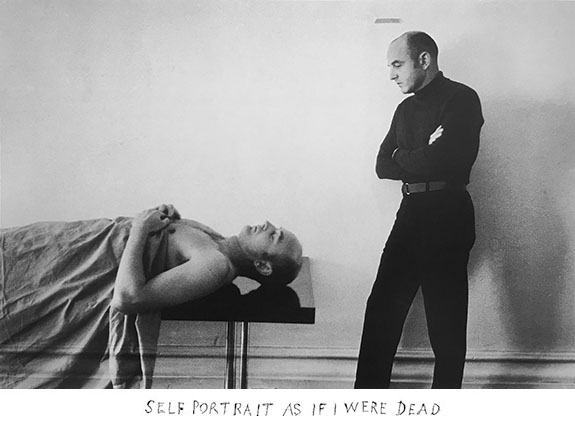
Journey of the Spirit After Death (1971), a book filled with ghostly double exposures that call to mind late 19th century and early 20th century spirit photography, minus the obvious darkroom tricks. A later portrait of Balthus (2002), made with a mirror held to one side of the artist’s face, reveals both sides simultaneously, one ravaged, the other a death mask. Through such seemingly straightforward means — double exposure and reflection — Michals turned the camera into a vehicle for transcendence.
As he explained to an audience at the Crocker: “The photo fails in its mere description…I’m interested in what it feels like rather than what it looks like. I had to stop photographing facts and start photographing feelings, and that’s very difficult. You have to invent.”
Born in 1932 in McKeesport, Pa., Michals, at age 14, began taking watercolor classes at the Carnegie Institute in Pittsburgh. In 1953, after earning a degree from the University of Denver, he served two years in the Army. He studied briefly at Parsons, but dropped out to take a job in promotions at Time, Inc. In 1958, at the height of the Cold War, he traveled to Russia with a borrowed camera and used the ensuing images to make his debut. Editorial assignments from
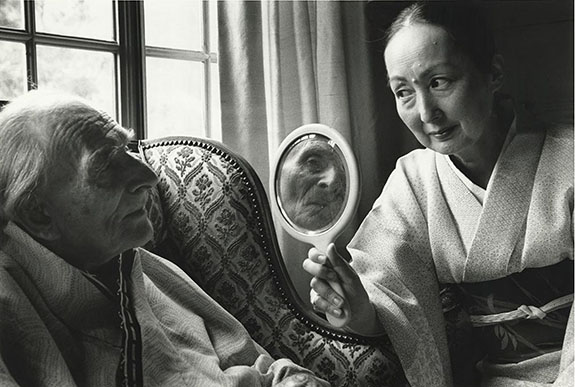
Harper’s Bazaar, Vogue, Mademoiselle and Esquire became his bread and butter. In 1970, MOMA awarded him a solo show, one of more than 100 that would follow. The Portraitist, a sampling of his photographs of public figures, reads like a who’s who of the post-WWII era: Philip Roth, George Ballanchine, Marcel Duchamp, Liv Ullman Johnny Cash, Andy Warhol, Martin Scorsese, Betty Davis, Norman Mailer, Carol Burnett, James Coburn, Leonard Cohen, Samuel Beckett, Louis Malle, Liza Minnelli, Dennis Hopper and a great many others.
Unlike his peers, he worked without a studio, preferring instead to make photos in natural light. “Once I find my light,” Michals once remarked, “the rest is butter.” A 1965 shot of Liza Minnelli outside a theater in upstate New York shows how he operated. In this, horizontal shadows cast from a fire escape onto a sidewalk echo the stripes of the singer’s dress, creating an improbable 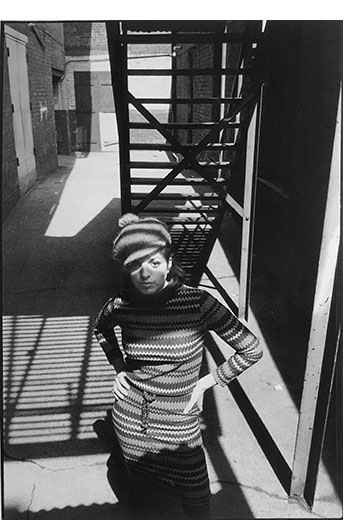
Michals, in person, cuts an impish, energetic, curmudgeonly figure: alternately bragging and self-deprecating, equal parts raconteur and empresario — characteristics that belie the seriousness of his art. It addresses death, transcendence, impermanence, sexuality and human relationships through a variety of devices that, while hardly unique, have become, in his hands, unique trademarks. These include multiple exposures; writing on prints; displaying images in sequence; painting on vintage prints; and, most notably, using mirrors and windows to create multiple views of human subjects within a single frame, unaltered by processing tricks. An aura of Surrealism prevails.
The best example (see lead image above) is an annotated six-image sequence titled Mr. Backwards Forwards (Tilda Swinton) from 2016. For this, Michals wrapped Swinton’s head in veils and removed them one at a time for each of five photos in which the androgynous actress held a sidelong glance. He could have stopped there and achieved his goal of creating a mythological creature – “a Sybil" he writes in the bottom margin of several images – but instead, he created a bombshell of a photo by shooting Swinton from the rear. For this, the culminating shot, she wears a sport coat backwards, leaving a blond ducktail in the place where her face should be. It appears off to the side, reflected in a hand mirror, a visual non-sequitur worthy of René Magritte.
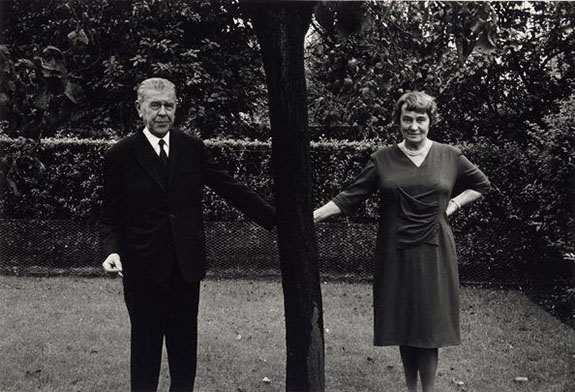
Michals’ images of the bowler-hatted Belgian, taken two years before his death in 1965, consist primarily of multiple exposures, most involving that famous hat. (Like Arnold Newman, famed for his so-called environmental portraits, Michals frequently employs the signature tropes of artists he photographs.) In this instance, however, I found myself drawn to a less-obvious image, one that shows the artist bare headed, holding hands with his wife, Georgette. Between them, at the spot where their hands clasp, a sapling erupts, cleaving the image into complementary hemispheres, signifying a marriage of co-equals. It’s a surrealist picture, but not of a sort Magritte would make – it’s much too tender. Yet it opens a window onto the private life of a legend. Michals’ portrait of Jean Dubufett, made in the artist’s studio, shows him in profile, a slack-jawed silhouette standing before a painting filled with his characteristic distorted heads, a juxtaposition intended to show them as self-portraits.
Over the years, Michals has expended a lot of energy criticizing the validity of the decisive-moment approach to photography. Yet it’s plain to see from The Portraitist that he had no qualms about seizing such moments when they fell into his field of vision. There are many

examples, but none as strong as his portrait of Joseph Cornell. In this, a wind-blown curtain photographed in direct sunlight obscures a portion of the artist’s backlit head and torso. The result is a knife-edged silhouette, a readymade Giacometti. It’s haunting, brilliant and unforgettable.
“Stand and stare” portraits constitute another large portion of Michals’ output. Such pictures, by the artist’s estimation, shouldn’t work, since they deliver only observable facts. But in Michals’ oeuvre, that rarely happens. Two images – one of Meryl Streep, made in 1975, just before her career blossomed, and another, of a stone-faced Leonard Cohen – demonstrate. Streep, flanked at the top left by bulbs, is radiant, poised for stardom, her face literally bathed in light. Cohen, shot in the 1980s on a balcony at the Chelsea Hotel, seems to have already assumed the role of folk-Pop’s Voice of God. Photos like these don’t just capture a moment; they forecast the future.
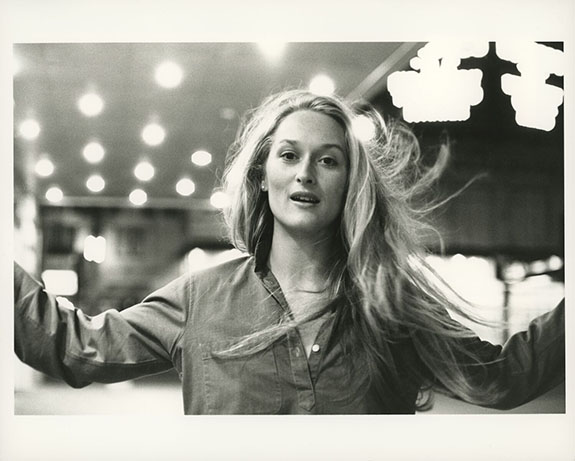
As I toured the show, the images I kept returning to were those I couldn’t reduce to their constituent parts. One of Johnny Cash, recorded at a New Jersey motel, shows the singer, chin-in-hand, with a reflection of the photographer superimposed. A window separates them, but their relative positions are impossible to discern. A photo of Joan Didion is even more inscrutable. Michals says he photographed the writer through a glass door, but there’s no evidence of it; all we see are eyes, nose, lips and the shadow of a bob-cut surrounded by hieroglyphics. It looks like something Kurt Schwitters might have built out of paper scraps.
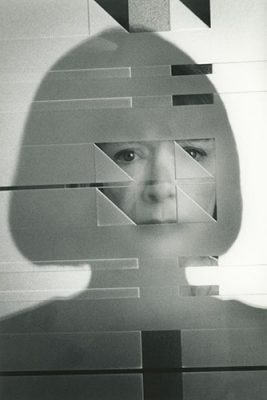
Heart-rending as such statements are, purists nevertheless regarded such incursions as heresy. Supporters, however, saw it as a jailbreak, a move that broke the tyranny of the decisive image and the perfect print, which, up to that point, no one, save Allen Ginsburg (who also
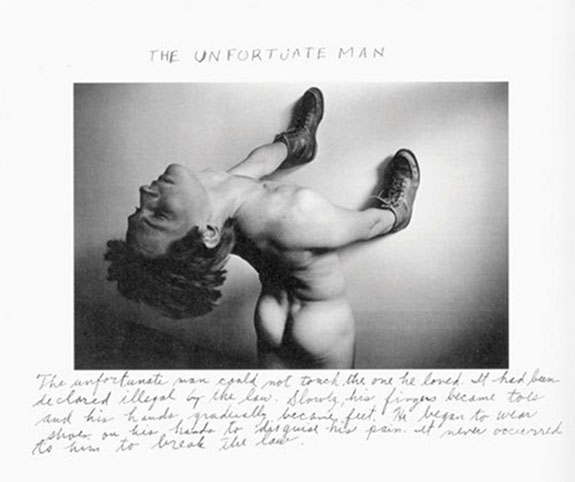
inscribed captions on his prints), had ever done. In so doing Michals pierced an invisible barrier, enabling photography to project and embody the sort of intimate knowledge that previously eluded it.
# # #
"Duane Michals: The Portraitist" @ Crocker Art Museum through January 6, 2019.
About the author:
David M. Roth is the editor and publisher of Squarecylinder.
What an excellent review. I look forward to seeing the exhibition.